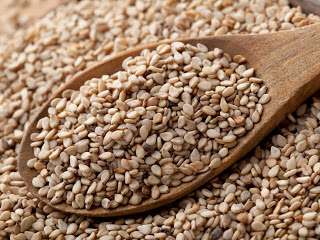
1 in 5 Australian adults are low in iron. Iron is an important mineral responsible for making proteins that carry oxygen in the blood to give our bodies the energy needed to function. Low iron can result in anaemia which can leave you fatigued, pale, dizzy and out of breath. It is more prevalent in women with menstruating women, pregnant and lactating women, teenage girls and female athletes being most at risk. The Recommended Daily Intake of iron for men is 8mg/day and for women it increases to 18mg/day to balance out what is lost in the menstrual cycle.
When asked to increase your iron intake your mind may think of a bloody red steak or even leap to the conclusion that you need iron supplements, but this is not always the case. There are plenty of iron rich foods that can be incorporated into your daily diet, so if you’re concerned that you’re not getting enough iron continue reading to discover the 5 most under-rated iron-rich foods.
- Sesame seeds – Nuts and seeds are a good source of healthy fats, fibre, vitamins and minerals, but sesame seeds have the highest iron content of them all! 100g sesame seeds have approximately 14.5mg iron! Now remember to be reasonable as it’s not likely that you’re going to sit down to a 100g sesame seed serve, but sprinkling a little on top of an Asian stir-fry or adding them to a home made marinade can be a good idea to boost your iron intake.
- Oysters – These little delicacies really pack a punch of nutrition. In addition to being a good source of protein, omega-3 and zinc, oysters are a fantastic source of iron. A 100g portion, which is equivalent to 6 medium oysters, will give you approximately 7mg iron. Just another reason to indulge in a few when you’re by the sea.
- Lentils – Lentils are a type of pulse and come in different colour varieties but yellow, red, green and brown lentils are most common.100g of lentils provides 3.5mg iron with virtually no fat and no cholesterol. They’re also a really good source of protein so don’t be scared to go vegetarian more often.
- Sourdough bread – Bread has been a staple in Western diets for centuries and is a good source of B vitamins, dietary fibre and iron. To increase your iron intake, I’d recommend a high-fibre sourdough bread: 2 slices (approximately 100g) provides 3.5mg iron.
- Kale – Kale is one of those new superfoods that we just can’t get enough of. Well, maybe that is because it is so good for you! Being a dark green leafy vegetable it is comparable with its cousin, Popeye’s iron-superfood, spinach. There is approximately 1.5mg iron in 100g of kale so continue adding it to your omelette, salads and green smoothies.
If you think you are at risk of being low in iron, or if it has been confirmed through a blood test, talk to your Dietitian about adding more iron-rich foods in your diet. If you have iron deficiency anaemia, your Dietitian can also recommend a suitable iron supplement for you to take to boost your levels and then monitor your iron intake to prevent further deficiencies.
To Do: think about which of these foods you need to increase in your diet.
